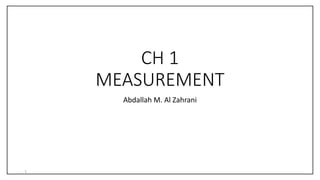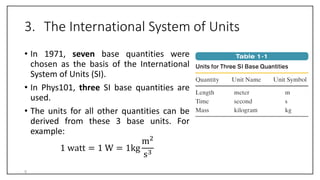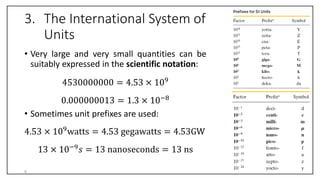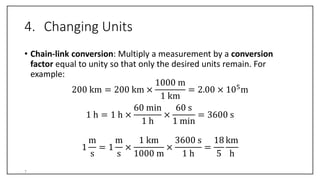This document introduces fundamental concepts of measurement and units in physics. It discusses:
- Physical quantities are measured by comparison to standards using unique units like meters for length.
- The International System of Units (SI) defines 7 base quantities including length, mass, and time that other units are derived from.
- Units can be converted using conversion factors that equal unity, preserving the desired units.
- Significant figures indicate the precision of a measurement and follow rules for arithmetic operations.
- Dimensional analysis requires physical equations to balance dimensions and can be used to derive relationships between quantities.















![9. Dimensional Analysis
• The physical dimension of the physical quantity 𝑥 (written as 𝑥 ) is the product
of the base quantities constituting it. In Phys101, [𝑥] has the general form
𝑥 = 𝐿𝑙𝑇𝑚𝑀𝑛
where 𝐿 = 𝐋ength, 𝑇 = 𝐓ime & 𝑀 = 𝐌ass . 𝑙, 𝑚 & 𝑛 are rational numbers
(mostly integers).
• Examples:
period = 𝑇
speed =
𝐿
𝑇
Area = 𝐿 × 𝐿 = 𝐿2
𝜋 = 1 (dimensionless!)
18](https://image.slidesharecdn.com/chapter1-240120133554-2818cfb2/85/measurement-units-slideshow-chapter-one-pdf-16-320.jpg)



![9. Dimensional Analysis
𝑃 = 𝑐 𝑔𝑎
𝑙𝑏
.
We have that
𝑐 𝑔𝑎𝑙𝑏 = [𝑔]𝑎[𝑙]𝑏= 𝑇.
Using 𝑔 = 𝐿/𝑇2
and 𝑙 = 𝐿 we get
𝐿𝑎+𝑏
𝑇−2𝑎
= 𝑇,
which gives us
𝑎 + 𝑏 = 0,
−2𝑎 = 1.
22](https://image.slidesharecdn.com/chapter1-240120133554-2818cfb2/85/measurement-units-slideshow-chapter-one-pdf-20-320.jpg)




